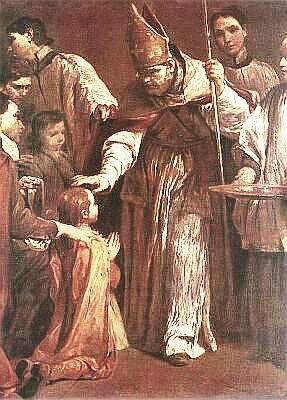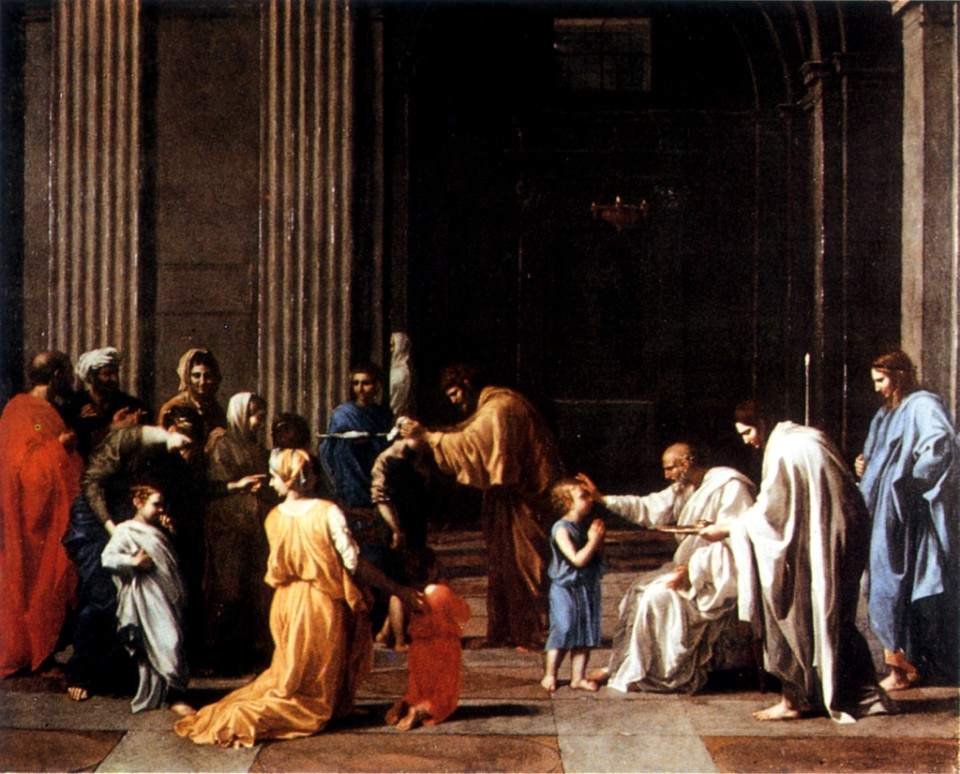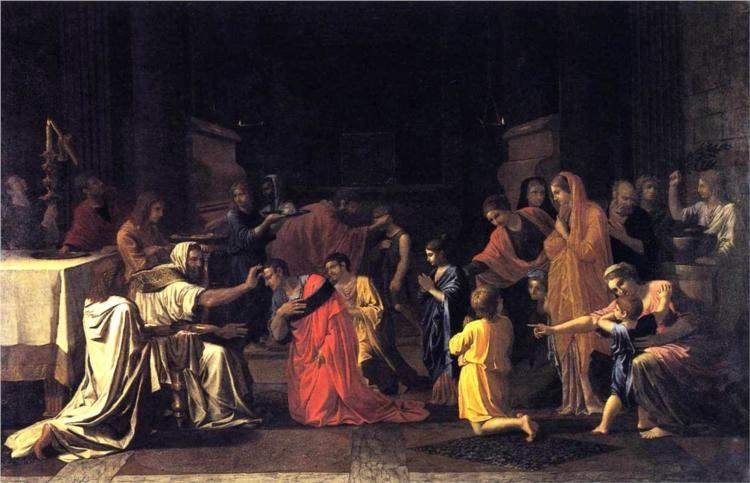I’ve given an introduction to the Sacrament of Confirmation — the Sacrament that brings to perfection the grace begun at Baptism, gives to the believer an even deeper outpouring of the Holy Spirit, and seals him or her by His anointing. In this post I will take a closer look at the Sacrament of Confirmation in Scripture and in the Church Fathers.
In Scripture
I have heard sola scriptura Protestants scoff that the Sacraments cannot be found in Scripture. They can. Though it is never referred to as “confirmation” in the Bible, the practice is clearly there:
Therefore let us leave the elementary doctrine of Christ and go on to maturity, not laying again a foundation of repentance from dead works and of faith toward God, and of instruction [διδαχὴν] about washings [βαπτισμῶν, lit. baptisms], the laying on of hands [ἐπιθέσεώς τε χειρῶν], the resurrection of the dead, and eternal judgment (Hebrews 6:1–2).
Note in the Greek the enclitic particle τε: it is unfortunately often not translated in modern Bible translations, as is the case here. It is a strong copulative, most simply translated and, but denoting a close, intrinsic, inseparable connection between the words or ideas it joins: in this case, βαπτισμῶν διδαχὴν ἐπιθέσεώς τε χειρῶν (baptismōn didachēn epitheseōs te cheirōn) should translate as “teaching of baptisms and laying on of hands” — with these two things sharing an inner bond as if part of the same action or idea. This verse is a reference to the Early Church’s “dual sacrament” of Baptism and Confirmation.
Also note the clear progression of ideas here: since the author is about to move from the “milk” of Christianity to “solid food” (Hebrews 5:12–14), he sums up the essential ideas: repentance from sins; faith in God; Baptism; Confirmation; Resurrection of the Dead; and Final Judgment. This is the path of the Christian life, the stages from Christian birth to Christian eternity.
There are at least two episodes in the Acts of the Apostles of the Early Church administering Confirmation to new converts. In the first, St. Philip the Evangelist (not St. Philip the Apostle; this Philip is one of the Seven Deacons ordained in Acts 6:1–6) has been down to proclaim the Gospel in Samaria (Acts 8:4–8). Philip baptized the new converts there — since any Christian may administer the Sacrament of Baptism (CCC 1256). The new Christians received baptismal grace, and in some measure, the Holy Spirit. But because only an Apostle could carry out the Sacrament of Confirmation (and thus today only a bishop, or a priest to whom he explicitly delegates the authority), the Samarians did not receive this immediately. And so:
Now when the apostles at Jerusalem heard that Samaria had received the word of God, they sent to them Peter and John, who came down and prayed for them that they might receive the Holy Spirit, for he had not yet fallen on any of them, but they had only been baptized in the name of the Lord Jesus. Then they laid their hands on them and they received the Holy Spirit (Acts 8:14–17).
Here, by the laying on of hands, the new Samarian Christians are confirmed in God’s grace and receive the fuller measure of the Holy Spirit. Since, at the time St. Luke penned the Book of Acts, the Early Church was still fleshing out its theology and working to grasp fully the outpourings of grace that Christians were receiving, Luke’s theological terminology was still somewhat uncertain. We know that Christians receive the grace of the Holy Spirit at Baptism — so apparently these Christians had been baptized but not confirmed.
Another episode occurs later, when St. Paul ministers in Ephesus:
And it happened that while Apollos was at Corinth, Paul passed through the inland country and came to Ephesus. There he found some disciples. And he said to them, “Did you receive the Holy Spirit when you believed?” And they said, “No, we have not even heard that there is a Holy Spirit.” And he said, “Into what then were you baptized?” They said, “Into John’s baptism.” And Paul said, “John baptized with the baptism of repentance, telling the people to believe in the one who was to come after him, that is, Jesus.” On hearing this, they were baptized in the name of the Lord Jesus. And when Paul had laid his hands on them, the Holy Spirit came on them, and they began speaking in tongues and prophesying. There were about twelve men in all (Acts 19:1–7).
After Paul baptized these men in the name of Jesus, he laid hands on them — and they received the fullness of the Holy Spirit, as it had fallen at Pentecost. This is another clear example of what the Church came to call Confirmation.
In the Church Fathers
This is running a bit long. There are a lot of patristic quotations I could share concerning Confirmation. I will choose a few of the earliest and clearest.
Tertullian, writing ca. A.D. 200, demonstrates:
Then having gone up from the bath we are anointed with a blessed anointing of ancient discipline, by which people were accustomed to be anointed for priesthood, by oil from a horn from which Aaron was anointed by Moses [Exodus 30:22–30]. For this reason we were called “christs” (“anointed ones”) from “chrism,” which is the ointment which lends its name to the Lord. It was made spiritual because the Lord was anointed with the Spirit by God the Father, as it says in Acts: ‘For they were gathered together in that city against your holy Son whom you have anointed [Acts 4:27].’ Thus also the anointing flows on us physically, but benefits spiritually, as the physical act of baptism (that we are immersed in water) has a spiritual effect (that we are free from transgressions). Next, calling and inviting the Holy Spirit, the hand is imposed for the blessing (On Baptism 7–8).
St. Hippolytus of Rome, writing ca. A.D. 215, documents:
The bishop, imposing his hand on them, shall make an invocation, saying, ‘O Lord God, who made them worthy of the remission of sins through the Holy Spirit’s washing unto rebirth, send into them your grace so that they may serve you according to your will, for there is glory to you, to the Father and the Son with the Holy Spirit, in the holy Church, both now and through the ages of ages. Amen.’ Then, pouring the consecrated oil into his hand and imposing it on the head of the baptized, he shall say, ‘I anoint you with holy oil in the Lord, the Father Almighty, and Christ Jesus and the Holy Spirit.’ Signing them on the forehead, he shall kiss them and say, ‘The Lord be with you.’ He that has been signed shall say, ‘And with your spirit.’ Thus shall he do to each (Apostolic Tradition 21–22).
Finally, St. Cyprian, writing A.D. 253, exposits the passage from Acts 8 I quoted above, and connects the episode to the Church’s understanding of Confirmation:
Some say in regard to those who were baptized in Samaria that when the apostles Peter and John came there only hands were imposed on them so that they might receive the Holy Spirit, and that they were not re-baptized. But we see, dearest brother, that this situation in no way pertains to the present case. Those in Samaria who had believed had believed in the true faith, and it was by the deacon Philip, whom those same apostles had sent there, that they had been baptized inside—in the Church. . . . Since, then, they had already received a legitimate and ecclesiastical baptism, it was not necessary to baptize them again. Rather, that only which was lacking was done by Peter and John. The prayer having been made over them and hands having been imposed upon them, the Holy Spirit was invoked and was poured out upon them. This is even now the practice among us, so that those who are baptized in the Church then are brought to the prelates of the Church; through our prayer and the imposition of hands, they receive the Holy Spirit and are perfected with the seal of the Lord (Epistulae 73[72]:9).
And so we see that the Church has practiced the Sacrament of Confirmation since the days of the Apostles. We reached the full understanding of it that we have today no later than the early third century.







